Ramipril (Synonyms: HOE 498) |
| Catalog No.GC15760 |
angiotensin-converting enzyme (ACE) inhibitor
Products are for research use only. Not for human use. We do not sell to patients.

Cas No.: 87333-19-5
Sample solution is provided at 25 µL, 10mM.
Ramipril (HOE-498) is an angiotensin-converting enzyme (ACE) inhibitor with IC50 of 5 nM.
Ramipril (HOE-498) is an angiotensin-converting enzyme (ACE) inhibitor with IC50 of 5 nM[1]. Ramipril (HOE-498) enhances the activity of ACE-associated CK2 and the phosphorylation of ACE Ser1270 in cultured endothelial cells, but is unable to activate JNK or stimulate the nuclear accumulation of c-Jun in endothelial cells expressing a S1270A ACE mutant or in ACE-deficient cells. Prolonged Ramipril treatment increases ACE expression in primary cultures of human endothelial cells and in vivo (mouse lung), which can be prevented by pretreatment with the JNK inhibitor SP600125[2].
Chronic in vivo administration of Ramipril (HOE-498) to rats at a dosage that has similar hypotensive effects in vitro HUVECs significantly reduces the rate of LPS-induced apoptosis compared to the other ACE inhibitors, which contrasts with the apoptosis effect in vitro[3]. Ramipril (HOE-498) inhibits systolic blood pressure (SBP) with IC50 of 1.97 mg/kg in spontaneously hypertensive rats (SHR). When in combination with AT1-receptor blockade by candesartan-cilexetil increases SBP reduction synergistically rather than additively[4].
References:
[1]. Raasch, W., et al., Combined blockade of AT1-receptors and ACE synergistically potentiates antihypertensive effects in SHR. J Hypertens, 2004. 22(3): p. 611-8.
[2]. Stevens, B.R., M.I. Phillips, and A. Fernandez, Ramipril inhibition of rabbit (Oryctolagus cuniculus) small intestinal brush border membrane angiotensin converting enzyme. Comp Biochem Physiol C, 1988. 91(2): p. 493-7.
[3]. Kohlstedt, K., et al., Angiotensin-converting enzyme is involved in outside-in signaling in endothelial cells. Circ Res, 2004. 94(1): p. 60-7.
[4]. Ceconi, C., et al., Differences in the effect of angiotensin-converting enzyme inhibitors on the rate of endothelial cell apoptosis: in vitro and in vivo studies. Cardiovasc Drugs Ther, 2007. 21(6): p. 423-9.
Average Rating: 5 (Based on Reviews and 9 reference(s) in Google Scholar.)
GLPBIO products are for RESEARCH USE ONLY. Please make sure your review or question is research based.
Required fields are marked with *




















